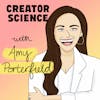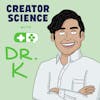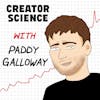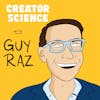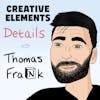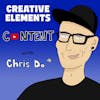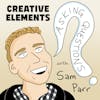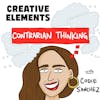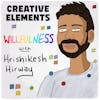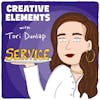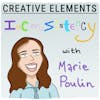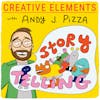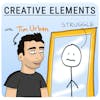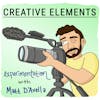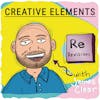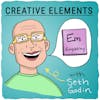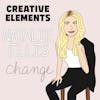
#132: Natalie Ellis of bossbabe – Attracting 3.5 million followers on Instagram (and what's working today)
Play Episodebossbabe is a community of female entrepreneurs – and it started on Instagram. Today, the bossbabe instagram account has more than 3.5 million followers.
WATCH
▶️ Watch this episode on YouTube
***
EPISODE DESCRIPTION
Natalie Ellis is the co-founder and CEO of bossbabe.
bossbabe is a community of female entrepreneurs – and it started on Instagram. Today, the bossbabe Instagram account has more than 3.5 million followers.
In this episode, you’ll learn what’s working TODAY on Instagram, how to make content that gets shared, how to turn your followers into email subscribers, and why you need to be open to change if you’re building your business on Instagram.
Full transcript and show notes
Follow Natalie on Instagram / YouTube / TikTok
Follow bossbabe on Instagram / Website / YouTube
TIMESTAMPS
00:00 - Natalie Ellis Is An Instagram Queen
01:42 - How bossbabe Grew So Fast
05:45 - Personal Brand Vs Separate Entity
07:35 - Qualities Of A Viral Instagram Post
09:31 - Being Relatable Without Being Negative
11:35 - Writing Is At The Core of Creativity
12:44 - Why Choose Instagram?
15:13 - How To Move Followers To Email
17:04 - Craft A Viral Instagram Reel That Converts
20:45 - Do You HAVE To Use Reels?
22:55 - Are Captions And Hashtags Important?
23:28 - In Feed Content Vs Stories
24:26 - Different Eras Of Instagram
26:14 - What Platform Is The Best To Start From Zero?
28:18 - Building A Personal Brand To Support A Company
31:05 - How To Approach Building With A Partner
38:16 - Product Strategy Masterclass For Creators
44:56 - How To Prioritize What You Should Be Doing
46:39 - How Being A New Mom Changed Natalie’s Work
***
CONNECT
🙏 Make a guest or mailbag request
📝 Check out our curated Playlists
***
SPONSORS
💼 View all sponsors and offers
***
SAY THANKS
💜 Leave a review on Apple Podcasts
Learn more about your ad choices. Visit megaphone.fm/adchoices
Jay Clouse 00:00
Instagram is one of the biggest social media platforms on the planet. It has evolved a lot throughout the years from stories to reels. And during that time, Instagram has served as a springboard for a lot of today's top creators. But is there still opportunity for new creators on Instagram,
Natalie Ellis 00:17
back in the day was was less saturated, it was a lot easier to grow, you didn't have to have a specific niche, you didn't have to be an absolute content machine, you'd have to be hooking people's attention and milliseconds. Now you do.
Jay Clouse 00:30
That's Natalie Ellis, the co founder and CEO of boss spade.
Natalie Ellis 00:34
It started with really sassy like tongue in cheek entrepreneurship, ambitious quotes. And that really took off because we were speaking directly to a certain persona. And that really, really worked.
Jay Clouse 00:48
Today, the boss babe account has more than 3.5 million followers on Instagram. And what I love about Natalie, as a creator is that she's not just building a personal brand, she's actually building an organization.
Natalie Ellis 00:59
The way I think about my business is more entrepreneurial than from kind of a creative perspective. I don't think about building a really lean team where I'm running everything I think about building a real business that can run with or without me.
Jay Clouse 01:13
So in this episode, you'll learn what's working today on Instagram, how to make content that actually gets shared, how to turn your followers into email subscribers, and why you need to be open to change. If you're building your business on Instagram. I'd love to hear your thoughts on this episode. As you listen, you can find me on Twitter or Instagram at Jay Clouse tagged me, let me know that you're listening. And if you're here on YouTube, leave a comment down below, subscribe to the channel if you haven't already. And now let's talk with Natalie.
Jay Clouse 01:55
Talk to me about the past four or five years has it felt as fast as it sounds? When I listen to your talk about the story?
Natalie Ellis 02:03
Yes and no, it has actually for the first two years. It felt like it just was this hockey stick growth it took off so fast. And you know, part of that was I prepared for that I came into Wall Street with a lot of brand equity myself and as boss babe as a community had a lot of equity in that it was not necessarily monetized. But I feel like we didn't start from zero, we didn't start from scratch. We've been building this community, I've been building my own brand. And so when it took off, it was almost like this perfect storm of we had all the ingredients like when baking something, we had all the ingredients, we just never put it in the oven. And as soon as we were ready to we did that. And then it was hockey stick growth. And that brings with it its challenges too. It's not always just sunshine and rainbows. So it has in a way felt fast. But then the scaling challenges I think are the moments that slows things down and makes it feel like this is never going to end Am I ever gonna be able to catch my tail. And I think all entrepreneurs go through that. And I think your business has seasons where some feel fast, some feels slow. But some days does feel like did I just start this in my bedroom two minutes ago feels like they did
Jay Clouse 03:15
well help me deconstruct this a little bit because people listen to this, they probably want to get started quickly. And they're hearing you talk about like the the brand equity you had in yourself and in your community? Can you help us put some tangibility behind that understand what that equity look like or felt like that allowed for this quick growth.
Natalie Ellis 03:34
For us it was building an audience and community. So that was in two ways boss Bay, we'd been building a boss big audience and community for a long time. So we had followers, we had an email list. And with my personal brand, same thing. And as I was building those audiences, I didn't necessarily know what I was building for what it was going to be. But I knew what I was passionate about, which is, you know, entrepreneurship, and I was just sharing content around those lines. And I think there's a lot to be said for building an audience. I especially the the economy we're in now I talked about your insurance is almost being your your audience's being your insurance policy. So no matter what's going on externally and around you, you know, whether it's Facebook, ad costs rising, or just stopping working completely, or advertisers pulling out of brand deals, you've got this audience and community that are there for you. And that is very monetizable if you're providing value, and something that I think we did, right was build audience and community first. And that's one thing that I'll always take into any other business I start after this is really thinking about distribution, not just product, thinking about, okay, if I'm building something who am I selling it to, if I'm constantly reliant on other people's audiences and ad dollars to get my product out and seen by people? Is that really the right way of doing things?
Jay Clouse 04:58
Let's take one step back for people who Maybe not as familiar with the Boss Babes story, when you were building community and doing events, what did that look like and for how long, so building
Natalie Ellis 05:10
community for us just looked like posting on Instagram. And we were posting really niche content on Instagram, it started with really sassy like tongue in cheek entrepreneurship, ambitious quotes. And that really took off because we were speaking directly to a certain persona. And that really, really worked on my personal brand. It was bringing people behind the scenes of my first business what I was building, and really showing that the ups and downs of that I didn't know I was going to monetize that. But it was really showing the journey. And through doing those things, we were just able to build and attract an audience of really like minded ambitious women who wanted to follow along for the content. And through doing so got to no boss, babe, as a brand.
Jay Clouse 05:58
Did you have an intentional insight to say not only am I going to share content on the I am Natalie Instagram page, but I'm also going to build this separate brand to do this, because I feel like a lot of people in this position, they're posting to Instagram, they're sharing things, it's on their name, when should they be thinking about creating an entity that has its own name and its own like personality almost, versus just really doubling down on their their own name,
Natalie Ellis 06:24
I didn't think about it. So Bossard was an account was started by someone else. And I came into support with that a little bit later down the line a couple of years in, I didn't really think it was going to turn into anything. And eventually I started to feel really passionate about the community and I bought it outright. But I didn't go in with the intention of let me build this brand that doesn't have my face on it. When I had my supplement company, which was before boss babe, I actually built that audience before I built my own audience because I never thought of myself as someone that wanted to be, you know, in front of the camera. I love being behind the camera. And I would post curated content from our customers, or sort of like content, I was sourcing online, and we built an audience. And this was way back when this was early days of Instagram, we built an audience of about 35,000 people on there, which was huge at the time, not saying it's not huge. Now it was huge at the time. And it meant that when I launched this business type zero marketing budget to work with, when I launched this first business, I had this audience that I could sell to and we were shipping to over 60 countries. In a matter of weeks. It happened very quickly because I was building an audience. So early, early on, before I even had a brand I understood that there was power in building an audience online, and especially Instagram at the time, it was really powerful. From there, I started posting on my own account, discovered that was this BuzzFeed account started supporting on there too. And it really happened organically from there.
Jay Clouse 07:48
So at the time that you were beginning to support the boss babe account, and you're starting to post on your own. What was the game like then for Instagram? What was working? Well, what did what did audience building look like at that time?
Natalie Ellis 08:00
Static posts that were very shareable, and they didn't necessarily have to have a face in them. If you had a face on them. It was a lot of like fitness industry that was popping off at the time. But also pictures of your food, very Pinterest worthy pictures, everything was perfect and polished, and set up and staged. So that that was what was working on my food account on Busbee, really tongue in cheek sassy quotes. And it taught me a lot about going viral. And that hasn't changed. What went viral back then isn't necessarily gone viral now. But the real meaning behind it, why it went viral is exactly the same now. So back then what I noticed is the quotes that were going viral, were the things that people really wanted to say that women wanted to say, but didn't want to say it themselves. And so they would repost it onto their own accounts. Or they would like it, they would tag people in it, or even just by liking it, they felt almost validated by it, because we were seeing the things that they felt. And they wanted to say, as Instagram started to develop and add more features, and especially stories that was huge, because same thing was going viral. But it meant that people could share it on their stories and almost use our content as a way of saying this is what I believe this is what I stand for. It's very, very similar now, but perfectly polished quotes really crushed it. I mean, they still do now. But back then, you know, you could design them really perfectly. It wasn't like a tweet style that went viral. And over the years, I think we've gone from being perfect and poised to being more raw and unfiltered. Now you find that the content that goes viral or gets picked up the most is actually the least edited. So it's been a very, very interesting thing to watch and be part of.
Jay Clouse 09:44
I want to talk about this insight a little bit of people engage with the thing that feels like oh, I've been feeling this or I've been wanting this to be expressed and now someone else is saying it. I've heard that insight before and I've wanted to take action on it. But what I find for me is it often brings out like a cynical part of me He that even if I share that some people will be brought to it, but it's like a cynical person then. So is Have you experienced this? And is there a line where you can have this expression that isn't negative, I guess is what I'm asking because it's easy to lean into the negative side of things. But that doesn't seem like the healthiest attention to be bringing to yourself.
Natalie Ellis 10:22
Totally. And that was actually something that we had to think about with our brand values, what is it that we want to be known for? And we realized that it was often the kind of sassy quotes or really empowering quotes, that you would kind of feel nervous thing about yourself, like, I remember one of us back in the day that went viral was I'm not questioning what I bring to the table, I am the table. And it was very much that high degree of confidence, I know what I'm bringing to the table pain energy. And we had to have that discussion of like, what's the fine line between being empowering and confident versus being a bit cocky, and we had that conversation, and we we've tweaked accordingly as things have moved on. So I think you can totally do it. And it doesn't necessarily need to be negative or cynical. You know, sometimes things that people are feeling might be, they might be feeling really tender and sensitive, and a video that brings that out or calls it forward. Or they might be going through a time where they're feeling a lot of change, and a quote, sums up what they weren't able to, is really powerful. I think navall is really good at doing that his his quotes on necessarily negative or cynical. But in just a few words, he sums up what you've been trying to journal on for days. And I think there's a lot of power in that I think great writers online, especially on the ones that can sum up how you're feeling in a way that you could never do it. And you don't have to be negative to do that.
Jay Clouse 11:47
That's so true. I think I think all the way back, like episode 22 of the show, I talked to Matt D Avella. And it's when I articulated or understood that, even if you're in a very visual medium writing is so core to like, all aspects of creativity do you identify as a writer
Natalie Ellis 12:04
100% Yeah, I got started in business in copywriting. I love to write. And even now, you know, we are in a place where videos performing really well. But there's scripts behind those videos, there's arms behind those videos. And that all starts with writing, in my opinion, whether it's writing a really good hook, whether it's being able to take this really long story and condense it in a way that's going to grab people's attention and keep them engaged. I think all of that comes down to writing. And I don't think it's this kind of skill that has gone away. I think as we're moving into this new visual era, it's still just as if not more important, because you don't want to watch a video that the first five minutes is absolute waffle, you want something that hooks you in that sums up how you're feeling right away, or what you're looking for right away, and then delivers on that. And then perhaps ends with a specific action. I think it's really, really powerful.
Jay Clouse 12:57
So if you identify as a writer, and you're finding the success on Instagram, what prevented you from going all in on another platform that might have been like more riding heavy, because the perception I have is, you guys really focused on Instagram, and still to this day, like really focus on Instagram, and a lot of people in your position might be drawn towards? Well, let me go ahead and give Twitter a try. And it seems like LinkedIn is starting to do well right now. So how about I do that too? How did you guys fight off that temptation, if you even felt it?
Natalie Ellis 13:28
Email was always my number one. That's the thing that I really love doing and really cared about. And I've always done email marketing from, you know, the same time that I set up an Instagram account, I was setting up a newsletter. And so that's always been, I would say, the engine of the business. It's kind of hidden, because you don't really see it. Social media is the front and it sends leads and subscribers to your email list. But I think the real community building and the know like and trust factor is built on email. There were many other platforms, social kind of front rented platforms, I call them I say email is an owned platform because you do own that and you're not at the mercy of certain algorithms, rented platforms. There's Instagram, Facebook, you know, there was Twitter, like Twitter popping up. Pinterest is still renewal relevant. That was Periscope. Tik Tok. Now, there's there has always been distractions this entire time. I just know for me, I don't have the bandwidth to do all of those things really well. And so I thought, Okay, well, if I do social really well, if I do Instagram really well as my number one social platform and push people to email, those two things feel pretty solid to me. Is it a risk that Instagram might go away? Yes. But is that risk worth taking based on the growth I think I can get an Instagram versus being having my attention fragmented across multiple platforms. And I still feel that way. Now. I'm really interested in YouTube and I do want to lean heavily into YouTube because I feel like that content just has a way longer shelf life and Instagram is very, very short. But again, email will still be Get the core of that. So I'll start email first. And then I'll think about how I could repurpose that email into a YouTube video. So it's not more work, we didn't start a podcast till we're three years into business and only had millions of followers. And again, it was for the same reason of, unless I can put someone in charge of Instagram and keep it running the way it was, doesn't make sense to pull our attention off elsewhere. I just think when you say yes to one thing, you're saying no to another, and I've always been very conscious of what I'm saying yes and no to
Jay Clouse 15:26
when it comes to Instagram and moving people to email, what have you found to be the effective strategies of getting people who are sometimes a little less engaged? What kind of passing by watching stories? How do you get them to actually come into an email ecosystem from Instagram,
Natalie Ellis 15:41
right now the best way is if you can get a real that pops off, it goes viral, but it's speaking to a very specific kind of person. So I've had multiple examples of one wheel generating 10,000 Plus email subscribers, but it's been for a very, very specific lead magnet, opt in. So that's for anyone that's not sure what that is, that is a free guide, a free challenge, a free video, a free PDF, something that delivers a lot of value that lives behind your email wall, so they have to enter their email in order to get it, we've created reels that are very, very specific. So we have a freebie called 30 days of content. And it's a PDF where we've created content for people for 30 days. And it's very copy and paste. And we created a real that was calling people out who are really struggling and procrastinating on social content. And at the very end of the reel, we directed them to read the caption, the caption send them straight to the Lincoln bio that was so powerful for us because it spoke to a very specific kind of person. And it really called them forward. The kind of person scrolling that was impacted by this was the person that really needed the guide. And it just racked up so many views. So many likes, so many people tagging their friends saying I feel seen, and the downloads for that from that were phenomenal. And we've had that on multiple occasions. So the recipe really is get super specific on who you're going after, what is one piece of content that's going to hook them in right away, and make them want to take action, make them want to take the next step, and then make that next step very clear and easy for them. For people
Jay Clouse 17:17
who are just listening to the audio version of this. What does the what did the content of that reel look like? It was like a direct to camera? Are you speaking to it? Was it B roll with text? What did that look like?
Natalie Ellis 17:29
It was direct to camera and it was a lip sync video with text written on I've had so many of these, I actually can't remember the exact audio and text. If they if people go on my Instagram, I mean the best way it let's say you want to know how to grow your email list and you're in the YouTube growth space. Go and look at people that are in that space, go to their reels like swipe to the reel as part of their profile and scroll down all of their reels and look at which ones went viral. So you can do this on my profile, scroll down and see which ones went viral. See exactly what I did. And just don't copy the content or copy what like the way in which I format this video because none of this is original, we're all creating hooks, we're delivering quick bite sized value. And then there's a call to action. study how long the video was study what the call to action look like, study all of the little details of it. So for me, I create a lot of face to camera with lip sync audio because it's easiest for me honestly, I'm busy. Creating content is like the smallest part of my job now. So I'll set aside 15 minutes, I'll grab my phone, I'll watch a reel. This is my absolute Hawk, I watched one reel, and I stopped scrolling because I'm served a bunch of reels that are in the same niche as that. And I take the audio and I just lip sync to a bunch of them. I save them in my drafts. And then I go back later and start adding text call to actions. I make it relevant and they're just sitting there I don't necessarily go into it with Okay, I'm going to create a reel that has this hook this body this outro because I get really led by what's trending at the time. And that seems to really work for me in terms of virality
Jay Clouse 19:07
so on those reels where you have a call to action to read the bio to or read the caption to send you the link in the bio is that call to action just another caption on screen it says like read the caption or is it like an end card?
Natalie Ellis 19:20
Normally it's just text that pops up right on the end of the real thing we'd caption or Lincoln bio and it's just very quick. I normally time it for the last 60 to 90 seconds of the real No, sorry, lost one second to 1.5 seconds. I'm just thinking about it. So the one that I just posted today I put the read caption at there was 1.5 seconds left of the real generally my reels are about six seconds because I want people watching it from start to finish. Ideally I want them to watch it more than once call to action and the last second that will get people watching but not turn off right away because they're not thinking oh, she's just trying to direct me somewhere else. And then they'll either read the caption or they'll go jump to the Lincoln bio because they stayed for the content.
Jay Clouse 20:05
After a quick break, Natalie and I talk about how to take advantage of Instagram reels. And later we talked about her product and hiring strategies. So stick around, we'll be right back. Welcome back to my conversation with Natalie Ellis. As a consumer on Instagram, it really feels like they're pushing really hard. So I asked Natalie, as a creator, do we have to embrace reels in order to be successful on Instagram? Pretty
Natalie Ellis 20:28
much, yes. There are some people that are doing well, without it, it's very few and far between this same when Instagram has released any new feature, they really prioritize it, if we think about it, and just the business sense, you know, when they launch a feature, they've got a really small product team on it. So when they launch stories, the team that launch stories, to millions of users was tiny, and that team really wants budget to go and expand the team. So they really want their feature to work. And so they'll generally get a bit more algorithmic favor for using those features their users. And that will then show people on Instagram, whether it's sticky, or whether it's not, and they can make that decision to then expand the team. With reels, you know, they saw tick tock take off. And so they realize they needed to be able to compete in that kind of attention consuming way. And so you get a lot of algorithmic favor for doing it doesn't mean that you necessarily have to do that to go viral. I've still gone viral on static posts, but it's harder, you have to really get something that's going to hit. And it doesn't necessarily mean that Instagram is going to support you in going viral with it. With a real, they're going to support you in it. And so there's new features. Now, I think YouTube have had this for a really long time. But you can now select what kind of topics your reel is. And so there's actual meta data on this reel that tells Instagram, this piece of content is for mums of newborn babies great that mum with a newborn baby is going to see it on her explorer page now. So that doing lots of things that is just basically making it so easy to go viral. So that if I was starting out, I would just go with that I would not make it harder for myself, I would just go with it.
Jay Clouse 22:08
What's the status of hashtags and their importance on Instagram right now?
Natalie Ellis 22:12
They're not very important right now. They haven't been for quite a while I personally don't use them. I think if you're starting an account from zero and you want to throw everything at it, should I use a couple and kind of tell Instagram what your accounts about, but don't expect it to be a growth engine voile
Jay Clouse 22:28
captions? How much should we care about captions? And does it depend on who your audience is?
Natalie Ellis 22:33
Captions, again, are less important than they used to be. But they are still important. You really want to think about the way in which you're writing them. I talk about a headline to Deadline technique. So your headline really has to be a hook, it has to pull people in, and then you know the body, it should be succinct. It should be very clear. You're not wasting words. And then at the end, you know, what does a deadline to it? Whether that's, you know, though, you want them to see a call to action, something's disappearing. What's the thing that you want them to do? Make it super, super clear? That's really powerful. If you've not got something like that, if you've not got something with Thank you, but short people won't read it if it's not worth reading.
Jay Clouse 23:11
This is so good. Okay, last one. Now that you have, you know, three and a half million followers on this this account, not to mention your personal account. How do you prioritize reels or in feed content versus stories? With boss
Natalie Ellis 23:27
babe, I prioritize feed content, because it's not about me. It's not about Danielle. It's about our community. And so by prioritizing and feed content, that means we're serving content that really resonates with our community. With my personal account, I prioritize stories because it's more about me. And I love stories because it gives me a chance to bring people just behind the scenes in my life. It's really easy content to create. And it starts conversations. I have such deep conversations with my audience on Instagram, because they see a story they reply, they give me advice, they ask questions. I spend a lot of time in my DMs. And so for me, it just seems more worth it on my personal brand. Do it that way.
Jay Clouse 24:09
So we kind of started this conversation with at the time when you started contributing to the boss babe account before it was your account. static images were queen. I was gonna say King, I'm like, let's say queen is that yes. And now we're talking about reels. Was there an era or multiple eras in between where the game was different?
Natalie Ellis 24:30
Yeah. Before we moved from the perfect polished the reels we were still moving into that raw, unedited, more unfiltered phase. So putting pictures up that weren't perfect. And what I mean by that is an example of you go traveling and you're posting a picture of your breakfast and it's like seven plates of perfect pancakes and everything's so perfect the way that it's put together. Those kinds of things stopped getting engagement. So it went from Instagram being kind of like Pinterest to being a bit more real. And so that would be selfies posted that were more unedited, unfiltered, those kinds of things did really well, there was transformation pictures. So people showing the realness, the comparison, that worked really well. And then with quotes and things, we saw a move from things being so heavily designed to being a bit more raw and real. So that's when we saw the move from a well designed quote, to maybe a screenshot from a tweet, or a carousel from a tweet. Those kinds of things worked really well, people were also providing value in a more long form way they can do that and video now. But at the time carousels, they were performing really well with a hook and then some body content, kind of like an email, and then an end card, and I think was still moving in that direction of more raw, more real I think every year kind of when people are demanding more and more of that. That's what I've seen anyway, I can't see us going back to the perfect Pinterest polished five,
Jay Clouse 25:58
is it easier to grow now on Instagram than it was in those two times? Or was it easier, you know, six years ago, and we're kind of just out of luck.
Natalie Ellis 26:09
I don't think we're out of luck. But it's nowhere near as easy. I'm not, I'm not gonna lie about that back in the day it was was less saturated, it was a lot easier to grow, you didn't have to have a specific niche, you didn't have to be an absolute content machine, you'd have to be hooking people's attention and milliseconds. Now you do because there is a lot more content saturation out there. We are competing for attention in a way that we never had to before. And so you can grow Absolutely, but you're gonna have to work a lot harder for it. What I pick Instagram as my platform of choice if I was starting from scratch. Now, I don't know that I would. And I'm being totally honest about that. I don't know that I'd choose Tik Tok either, because from what I'm seeing from Tik Tok, if you really hit it, it can be amazing. But it can also be quite up and down. Just because you have a following on there doesn't necessarily mean your content is going to be seen by all the people that follow you every single time you post. So I would definitely think about the platform that I was going going to go on if I was starting from zero again, and how would you think about that? I would think about where my ideal clients are going to be. First and foremost thing that makes more sense. And then secondly, I'd think about how can I build know, like and trust factor the quickest? I'm wanting to start from zero, I'm not wanting to put a decade of work into building my personal brand. That's really important to me. And then I would think about how can I put the least input to get the most output because we're all busy. And so I would probably go YouTube personally, because I could spend time creating one video that's actually going to have a really long shelf life, it's going to bring in an audience for me if I do it, well, it's going to allow me to spend a good chunk of time with my audience, or I will do something like a podcast, same thing. You know, if it's done, well, you're building that know, like and trust factor really well with your audience. And it's just a short loop of building.
Jay Clouse 28:02
How do you think about the time you're spending on the Natalie universe versus boss, babe? And it doesn't have to be specific to Instagram because I know you're on YouTube and all these different platforms. So how do you decide this is the time when I should make content for my personal pages? And is that benefiting you? Or is it benefiting the company or both? I know people wrestle with this, and I'm curious to hear your take,
Natalie Ellis 28:24
to be totally honest with you, I neglected my personal brand. Almost the entire time I've been building boss, babe, it's always been a second thought. Because I was building a brand I was building boss, babe. And with that being said, my personal brand has always been such a big support to the company. If we're in a launch, the way in which it drives leads or conversions is almost being comparable, which is crazy, given the size difference in followers. But I think you know, people buy from people, right. And they it's a lot easier to know like and trust people with brands, it's harder to build that up. But then when you have it, you really have it. Now I'm starting to think more about my personal brand, just the phase in which I'm in I want to create content around that I want to bring people behind the scenes of my life right now. And I'm lucky in that I have a team to pull me with Boss Babes. So it's not like I have to neglect that account. I have a team that can keep things going while I also maybe turn my attention to creating content with my face on it.
Jay Clouse 29:25
So you said like sometimes the personal brand supports the company. So well, if you had some new interests that you got into maybe you wanted to talk about just like being a new mom. And that was where you wanted to go with your personal brand. Does that have a risk of detracting from the company or making people think oh, I guess Natalie's not taking this other thing as seriously as she used to? So I'm going to divert my attention now to what she's doing now. Have you thought about that? Because I can see myself struggling with that.
Natalie Ellis 29:52
If I'd done it a couple of years ago it absolutely would have it would have I think distracted from Boss babe. Now boss babe is a brand In itself, and I don't think people think about boss, babe as being Natalie and Danielle, I think they think about it as being boss, baby. And me and Danielle, are separate in that we have our own accounts. And we have our own things that we talk about. And we're very different. And so now I think it's more an expectation from our audience that we are different. And we bring different things. So boss favors this brand that stands alone. And then our personal brands, they're kind of like an edge, they bring a uniqueness to what we're doing. So I don't feel like it would change things. Now. Again, my face isn't on the boss account so much got a couple of years ago, my face was still on stories almost every single day, it hasn't been for a really long time. So people are coming to Boston for the Boss Baby content. So making that transition was really important before even thinking about spending any time on my personal brand.
Jay Clouse 30:48
I want to talk a little bit about your partnership with Danielle. Because most of the folks that have on the show are solo creators, they they get to have like full decision making authority and anything goes well on them. Everything goes poorly is on them. People listening to this who feel like you know, I might be someone that would like to work with somebody and partner with somebody, can you help talk through how they should approach that to set themselves up from six for success from the beginning?
Natalie Ellis 31:12
Yeah, you really want to think about what you're each bringing to the table? And so do you have skills that really complement each other? And together? Can you build something better than you would be building on your own? I think that's firstly, really, really important. Secondly, is this someone you want to be in a legal partnership with, I think business partnerships kind of like a marriage, honestly, because you together are creating and building assets. And that's not something that you want to take lightly. And if your business partnership fails, likely your business is going to fail to or it gets really, really messy with me. And Danielle, we've always thought about and prioritized our relationship knowing that it's going to take work. And then if we don't prioritize that, the business can thrive. It's like having kids with someone, right? If you think about the business as a baby, your baby is really only going to be doing as well as the health of the overall relationship. So that part's really, really important. And so having those upfront discussions with a potential partner is very important. What is your role going to be? What are you going to contribute? What can I expect from you? And okay, if we come into disagreements, how do you generally handle them? How can we agree on being able to come to decisions? What do you have, say on that you can kind of make final call on and what do I have, say on that I can make final call on how can we avoid ever being in a tiebreaker situation, all of this might be uncomfortable to talk about upfront, it's so incredibly important. Beyond that, beyond those tactical things, I think you have to have a conversation about what you want the vision of your life to look like beyond the business, think about the business is just a vehicle that's going to help you get there. But if your life vision is completely misaligned from that of your business partner, you're probably not going to be rowing in the direction in the same direction. If your business partner wants to build this big business, where they get paid out through an exit, and they don't necessarily care about taking cash out in the interim, and they don't really care about having freedom in the interim, because they see this North Star and that's where it's going to come from, great. Are you aligned with that, because if you want to cash flow forward business where you actually going to have a lot of lifestyle freedom, you don't want to sell it, you want it to just be this engine that generates revenue for you and you're doing something enjoy, then you need to find a partner that has those same values. And you have to be really honest about that up front, don't just say what you think the other person wants to hear. So you can get into partnership with them. It's like you're going from dating to getting married real quick. So you better have those uncomfortable conversations.
Jay Clouse 33:45
This is one of the most important questions I feel when you're going into partnership, because the struggle I see a lot of people have, they liked the idea of partnership. And they like the idea of both of being able to work with somebody. So it's not as lonely. And theoretically like you can do things twice as quickly because you have twice as much power going into it. But everything starts at zero. And the struggle I see with a lot of potential partners is they can't figure out the initial money part of this because it's hard to build a business that supports one person, let alone two people. So how should people approach that if we're starting from zero with a partner to think, how do we make this reward both of us when it starts with so little in the beginning?
Natalie Ellis 34:22
Yeah, that's a really, really important conversation. And just like in romantic relationships, money's often a really big sticking point with co founders, again, those honest conversations, what are you bringing to the table in terms of revenue and growth? How are you able to support the growth of this business? Because if it's just me, am I going to be compensated differently for what I'm bringing, or if you're not driving revenue, but you're doing something in the back end? And that's actually really, really supportive to be able to bring in revenue and stabilize the company so we can hold more customers? How do we compensate you for that? And coming up with a bit of a framework that you agree on in the beginning, so that As you get into this partnership, and you got a couple of debt years down the line, and you're not talking about some arbitrary number, but you're actually talking about money in the bank, you have the same kind of freedom framework that you both agreed on back then that you can use, then I think that's really, really important. Money is always going to be something that you have to be talking about whatever kind of partnership you're in, it has to be something you talk about. And if you avoid it, I think that's where a lot of problems will come from.
Jay Clouse 35:26
Yeah, it almost sounds like you're talking about kind of performance milestones and metrics in a way, because I think a lot of people just assume that, okay, if we're both starting this, and it didn't exist yesterday, this must be a 5050 partnership. And whatever money comes in, we just split it in half. But it sounds like you're advocating for putting some more deeper thought into it and making it more match up with what you're coming in with as opposed to saying, well, it's starting from zero. So 5050 everything down the middle.
Natalie Ellis 35:54
Yeah, well, I think it warrants conversation. I don't think it should just be okay. Because we're both starting this from zero, we both get 50%. What if one person has a job and that they're working full time in and you're full time in the business? How do you work that out, because that person might say, You know what, I'm going to stay in my my job so that I have that security. So you're going to be the one that gets paid. And when it makes sense, I'll transition into the business, it wouldn't then be fair if the person working full time got paid the exact same amount as someone who's only putting in a couple of hours. And so you have to have these conversations. And even if you end up at 5050, and everything split down the middle, at least you're comfortable with that decision, and you didn't go into it as a default.
Jay Clouse 36:35
When we come back, Natalie and I dig into her product strategy and how she thinks about selling to an audience of 3.5 million people right after this. Hey, welcome back over the years, boss, babe has experimented a lot with their product strategy. At times they've sold no products at times, they've sold just one product. So I asked Natalie, after years of experimentation, how should new creators think about their product strategy?
Natalie Ellis 36:59
So I think the first thing that they should do is get really clear on an ideal assumption model. So not saying you're going to build this, but get really clear on an ideal ascension model, someone that starting from the absolute beginning, the first thing they buy from you, what would an ideal ascension look like? Because businesses that are able to resell people over and over and over again, are businesses that do really, really well. And so think about that, think about that model, and then looking at it, decide where you want to start? Do you want to start the most expensive product that's going to be, you know, for fewer people, but it's going to help you build curriculum, or it's going to help you gather data that's going to support your other products? Or do you want to start right at the beginning and build things out slowly as the becomes more demand for it. I think that part's really important. Second to that, think about distribution. So it's all well and good having a great product idea, but how are you going to sell this thing, if you come up with an idea for like, let's say a low ticket membership, let's say something under $50 a month? Great, you're gonna need a lot of people in order to sustain that and make it worth your while. So how are you going to sell it? Do you have enough people that you can sell to? Or do you have a great sales strategy? If not, maybe it's, you know, the time that you're going to think about building that figuring out a way to make that happen, or build something different? Those things I think, are really, really important. The actual product, you can get really nitty gritty in that, what is it? What is it delivering? What is the price point, all those things, but if you don't know what the overall journey is, and how you're going to reach those people, initially, I think you can end up spinning your wheels, and maybe creating something that didn't, doesn't take off. And
Jay Clouse 38:35
for people who are listening to that or saying what is ascension, you're saying basically products or products, there's a whole pipeline of steps people will take in working with you. They're trying to get to some outcome. And you can build products all along the way that goes step by step to that outcome, and you're saying ascension, meaning what points the journey Do you want to serve? Right,
Natalie Ellis 38:54
exactly. Let's say you start working with a functional medicine doctor, and you go in and you're like, you know what, my keep going bad stomach, my gut feels really iffy. And they're like, Okay, we're gonna run a few tests. And I'll, I'll help you troubleshoot that, that's the first way in which you work with them. And then they come back and say, you know, what, why don't we look at your body as a whole? Should we run a few more tests and just do a workup of where you're at right now? And so you then do that? Maybe they then come to you and say, Okay, we see your results? Why don't I create you a 90 day protocol, and I just give it to you, and you're gonna go follow it on your own. And you go do that. And then you go back to them. And then they might say, Okay, we're in a really good place. Now, why don't I coach you weekly on being able to optimize where you're at? So at each step, they've been adding things on just like going to the dentist, and each step that adding things on and at that point, you can decide, do I want more of what I'm getting? Or do I want to stick with where I'm at?
Jay Clouse 39:50
Yeah, that's the next point I wanted to drill into because this is a challenge I see with a lot of people is they will paint this big vision in their mind of their full ascension model to know okay, and a full He realized version of this business, this is what I can do for this type of person. And it's actually, you know, 10 different things. And they get to work, building like an MVP of every step of that, as opposed to maybe building the first step doing it really well. And doing that for a couple of years, and then adding on. So how would you advise someone approach to that? When should they build the next steps in this ascension model? versus say, actually, I'm going to audience build to further pull people into this one product experience I've done? Well,
Natalie Ellis 40:30
yeah, I really don't think they should build multiple products until that one product is sustaining itself. And what I mean by that is, let's say you have been attracting, let's just call it 100 customers, every month, for six months, you're like, Okay, this is really steady, could I put someone else in charge of this, and it's going to come, like continue growing at 100 customers per month, can I do that, can I step away to then put my attention somewhere else. And this is going to keep going. I think that is the point in which you can focus on something else. And you can build something that maybe, you know, if you're getting 100 people into this product every month, there's going to be five interested in the next step, you're building the next step your distribution is already taken care of. Because there's one product doing really well, I think you have to have that dialed in. Because what I see a lot of time is people jump to the next product, they get shiny object syndrome a little too early. And this one product that was the focal point of their business and was doing really, really well starts to decline. They're either not bringing in clients consistently anymore, they're not delivering the results that they used to, you know, they're not building the same relationships and happiness that they were before, then you're kind of starting from zero again, and you're back on this hamster wheel. And all of a sudden, you've got all these products, and no one to sell them to.
Jay Clouse 41:44
Something interesting to you just said was sustaining itself. And putting someone else in charge of that product. That's something I don't find a lot of creators thinking about is hiring to lead a product within your company, they think that they have to run and support every product all along the way. So I'd love to hear a little bit about how you think about hiring and expanding the team to support these products. Because that's a perspective, we haven't heard a lot here.
Natalie Ellis 42:12
Well, let's say you have a baby, right. And you also want to be working on your business doing both. But the baby holding the baby at the same time is difficult, you're then going to get a nanny, or you're going to put your baby in daycare, so you have a bit extra time to work on. The other thing. It's exactly the same with business and products. And I think building teams are really, really important. I would say I'm an entrepreneur before I'm a creator. And the way I think about that, or the way I think about my business is more entrepreneurial than from kind of a creator perspective, I don't think about building a really lean team where I'm running everything, I think about building a real business that can run with or without me, and putting people in place. So when I think about hiring, let's say you're going to hire your first person, I would be thinking about what are all the things you're spending your time on that aren't moving the needle in your business, what could they be outsourced to, let's say, you know, you're making $50 an hour on your business, but you can outsource 50% of what you're doing for $25 an hour, so that you can be doing more $50 An hour things, I think that makes sense. And for me the way I've thought about my businesses, there has to be an owner of each channel and each product within the business. And that's not going to be me unless it's a brand new thing. I think as an entrepreneur, my skills lie in getting brand new things off the ground and making them work and then handing them off to someone that can keep things going. That's worked really, really well for me. And you can find great people that can do that for you and your business.
Jay Clouse 43:39
I want to take the last bit of time, we have here to talk a little bit about collaboration, because I know that's a huge value that you've always had in the company. And if I'm listening to this, and I'm already kind of overwhelmed with all the things I could be doing with my time, right, I could be building this product. I mean, this experience really good. I could be creating content, how would you weigh or prioritize the time to form collaborations with other people amongst all the other things I could be doing as a creator?
Natalie Ellis 44:05
The way I think about anything like this is I think about my North Star, what's the thing that I'm driving towards, and I run every decision through that North Star, if your North Star is to have 100 members in your membership, that's the thing you're really driving towards. If a collaboration is going to help you hit that goal, great, maybe think about doing that. If it's going to distract, and it's actually not going to help you hit that goal. Maybe it's going to open you up to something else, you're not 100% sure what it is, comes down. Do you want to be opened up to something else? Or do you want to keep moving towards this Northstar? And I think you have to be willing to turn opportunities down you have to be willing to, quote unquote, leave money on the table in order to get where you're going. I can't tell you over the years how many times people have said you're leaving money on the table by doing that. But actually, am I or am I putting more money on the table because I'm focused? I say no to more things than I say yes to. You know, I don't just hop on everybody's podcast. I don't just become an affiliate for everyone or let people affiliate for me. I don't just collaborate on content on social with anyone. It's very, very unintentional. And it's based on what are what's the season I'm in with my business? What are the goals? I'm working towards this quarter this year, this decade? does it align? Okay? I'll do it. If it doesn't mean, I'm going to say no. And my boundaries are going to be really clear around that.
Jay Clouse 45:21
How has being a new mother changed the way that you approach business or think about your business,
Natalie Ellis 45:27
I have a lot less time these days. And so I my boundaries have had to get really, really strong. And you know, I think about checks before I became a mom, I wasted a lot of time on certain things in meeting that I really didn't need to be in or, you know, reading slack or scrolling on social when it really wasn't moving the needle. So for me, the way I think about my work now is when I'm at my laptop, and I'm working, I am working, there is no distraction. I'm not taking a meeting that does not absolutely needs to be taken. And I've created a lot of boundaries around that. And the other way that I think about work now is I find being among really fulfilling and I absolutely love it. I love spending time with my daughter. And if I'm at work doing something that feels really draining, and it's really not enjoyable, I kind of weigh it up of do I really want to be doing something that feels this kind of unfulfilling, when I could be going and spending time with my daughter that would feel great. And so the work that I do now it has to light me up and it has to feel fulfilling. And it also understand that I'm in a privileged position, being able to say that because I've spent a decade building my businesses building my wealth that I do have a level of freedom that not everyone has at this point. And that has really worked in my favor now because I get to pick and choose what I spend my time on.
Jay Clouse 46:49
I thought this conversation was refreshingly honest about how difficult it can be to start and find traction on Instagram today. It's not impossible, but I want you to go into it with eyes wide open and I think that applies to all platforms. If you want to learn more about boss Babe, you can visit their website boss babe.com or Boss Baby dot inc. On Instagram links to that as well as Natalie's personal accounts are in the show notes. Thanks, Natalie for being on the show. Thank you to Khan Academy for editing this episode and Nathan Todhunter for mixing our audio thank you to Emily Klaus for making our artwork and Brian Steele for making our music. If you enjoyed this episode, tweet at me or find me on Instagram at Jay Clouse, let me know I'd love to hear it. If you really want to say thank you, please leave a review on Apple podcasts. Thanks for listening, and I'll talk to you next week.
Most Popular Episodes
New to the show? Check out some of our most popular episodes.






